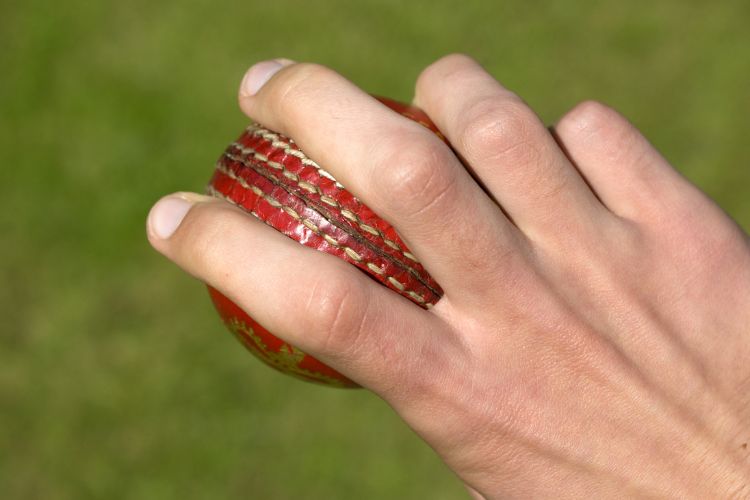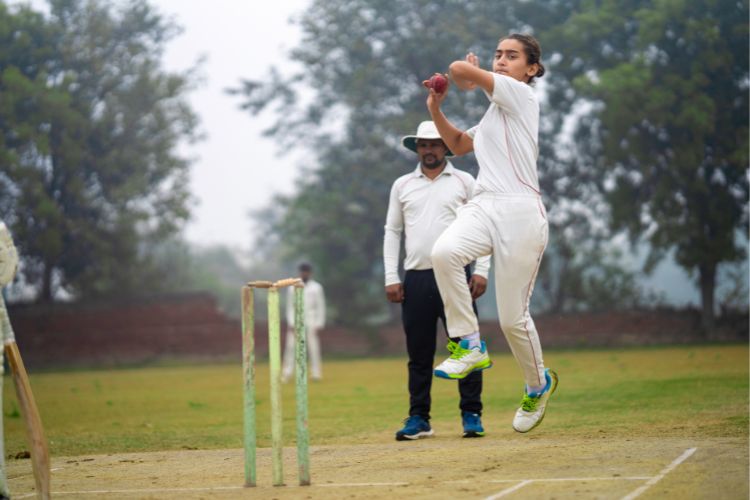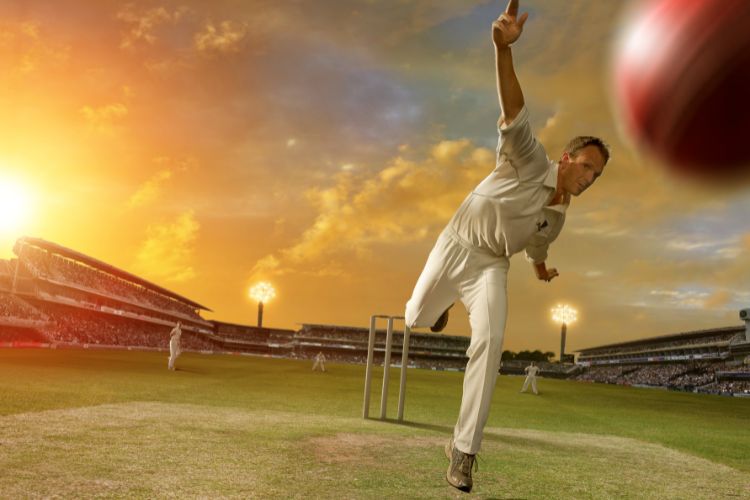Fast bowling is an art that combines speed, skill and precision. It’s not just about throwing the ball as fast as possible. It involves mastering several fundamental techniques that contribute to the effectiveness and speed of the delivery.
Introduction to Grip, Run-Up and Delivery
To become a formidable fast bowler, you need to understand three core components: grip, run-up and delivery.
Each component plays a vital role in the execution of a fast ball. Changing the grip on the ball changes the direction the ball is delivered and how much, if at all, it swings. The run-up builds the momentum necessary for a fast delivery, and the delivery itself is the final execution that determines the speed and trajectory of the ball.

Let’s look at grip first. The typical grip for a fast bowler is what could be called the ‘seam grip’. Hold the ball with your index and middle fingers on top of the seam and the thumb beneath it, on the other side of the ball. This position allows you to maintain control over the ball’s seam and direction, facilitating swing and seam movement off the pitch.
Small adjustments in the grip can lead to significant changes in the ball’s behaviour; for example, holding the ball so that the fingers go across the seam, rather than along the seam, may introduce variable bounce to the ball. Holding the ball with your fingers along the seam but spread further apart might introduce unpredictability to what happens when the balls hits the pitch.
We’ll talk about these variations in later posts relating to Swing, Seam and Delivery Variations.
Next, the run-up. There is a reason why fast bowlers don’t take just a couple of steps and let it rip. Run-ups build momentum, which is added to the speed of the ball at delivery time. This can also reduce stress on the body, particularly in their arms and shoulder, as the bowler doesn’t have to rely on their arms and shoulders to create the entirety of the speed of their delivery.
A good run up should be rhythmic and reproduceable, tailored to your individual style as well as your physique. The run up should start slowly and build in speed, allowing you to gather energy that will be transferred into the delivery itself.
The length of the run up varies from bowler to bowler. Some bowlers prefer a long run up to build more momentum, while others opt for a shorter more controlled approach to maintain better balance and precision.
You should practice your run up at the nets, reproducing what seems to work well with you and adjusting those things that seem to be hindering you. You can look at the run ups of famous bowlers and begin by mimicking them, but ultimately your run up has to suit you.
Finally, there’s the delivery. This is the climax of the bowling action. It involves a coordinated effort of the whole body to channel the built-up momentum into the ball. You want to make sure that your leading arm is high to help direct the ball; following that, you want to generate fast arm speed, and you need to brace your front leg at the point of release.
This will act as a pivot for the transfer of your body weight and energy.
Your follow-through is also crucial. It aids in controlling the line and length of the delivery while ensure your body decelerates safely after the ball is bowled.
Many fast bowlers over the years have their own unique techniques that you can learn from, taking aspects here and there, and combining them into a bowling technique that suits you and your body type perfectly.
For example, Dennis Lille combined a perfect run-up with a classical side-on action, maximizing his pace and control. Waqar Younis, known for his lethal reverse swing, had a shorter run up, but used an explosive delivery stride to generate great speed and movement.

Glenn McGrath, SCG, 2007 No machine-readable author provided. Roo72 assumed (based on copyright claims)., Public domain, via Wikimedia Commons
Glenn McGrath, another great of the game, used impeccable line and length achieved through a consistent and methodical approach to his run up and delivery.
By examining these foundational elements and the techniques of past greats of the game, you can develop a deeper understanding of what it takes to excel at fast bowling. Mastery of grip, run-up, and delivery not only enhances you speed but also your ability to maintain accuracy and effectiveness over time.
Building the Fast Bowler’s Fitness Regime
Physical fitness is a core component for effective fast bowling. A well structured fitness regime will help you to not only increase your pace but also to sustain your bowling speed over longer spells and prevent injuries.
This might depend on your age, of course; a lot of the following fitness exercises might be more appropriate to an older player, but even younger players need to ensure that they have the strength and fitness to endure the strains and stresses that go through the body during a delivery.
It must be remembered that the bowling action is not a natural motion for the human body to make; much strain is put on the back, hips, knees and ankles. For a bowler bowling at just under 130km/h (which, in international cricket, is considered only medium pace), the force that goes through a bowlers legs and spine at the point of delivery, can be seven to eight times their body weight.
It has been calculated that this is the same amount of force as subjected on a player in a rugby scrum. And bowlers are expected to do that six times an over, and bowl 10, 15, 20 overs a day.
Even if you’re not bowling at 130km/h, the bowling delivery stride is still a stress on your body that it won’t be used to, until your get it conditioned.
Fast bowling demands explosive power, speed, and sustained energy, all of which are underpinned by a bowler’s physical fitness. A fitter bowler can generate more speed, deliver more balls without tiring, and is less likely to succumb to the common injuries associated with the high impacts of fast bowling.
Strength:

Strength training is fundamental for building the muscle power required for fast bowling. Exercises focusing on the core, shoulders, legs, and back are crucial.
Squats, deadlifts, and bench presses build the lower body and core strength that contribute to a more potent delivery stride, while overhead presses and rowing strengthen the upper body for better arm speed and control.
Speed:
Speed drills enhance a bowler’s run-up velocity, directly influencing their ability to generate momentum. Sprinting short distances, agility ladder drills, and hurdle jumps can significantly improve a bowler’s acceleration and footwork.
Endurance:
Endurance training helps fast bowlers maintain their intensity throughout a game. Activities like long-distance running, cycling, or swimming increase cardiovascular fitness, allowing bowlers to recover more quickly between overs and maintain a consistent pace.
Overall, the best fitness regimes for fast bowlers are those that integrate seamlessly with your skill practice. You can do this by incorporating your bowling action into the fitness routine. Try to perform bowling sprints with a weighted ball, or setting up simulation exercises that mimic game scenarios.
This holistic approach ensures that every aspect of a bowler’s fitness regime enhances their overall bowling performance and resilience.
Bowling Action and Biomechanics – Crafting Speed with Precision
The three primary bowling actions in cricket are side-on, front-on and mixed.
In a side-on action, your front shoulder should point towards the batter while your chest points at right-angles to the batter; this type of action can help you get greater swing, but unless you are precise in the placement of your hips and shoulders, it can cause stress on your back.
In a front-on action, your chest is facing more directly towards the batter; with this type of action your sacrifice swing, but gain speed.
The third action, the mixed action, combines elements of both actions – your chest might be partially open at delivery; this offers a balance between swing and speed, though it can still cause some stresses in your body.
Biomechancis – The Science Behind Each Action
Biomechanics plays a crucial role in understanding and optimizing each type of bowling action. It involves the study of the forces and mechanical principles that govern human movement, applying this knowledge to improve performance and reduce the risk of injury.

So, let’s look at the three different action types, and delve deeper into the biomechanics of each action.
Side On Action
We’ve said that the side-on action is particularly effective for generating swing. This is because the position allows you to use the seam of the ball to cut through the air in a way that promotes lateral movement. Your arm’s vertical swing through delivery helps maintain the seam’s orientation, enhancing the ball’s ability to swing in the air.
However, the strict alignment required in the side-on action can place significant stress on the lower back and spine, particularly if the bowler does not rotate the spine smoothly during the delivery. This action relies heavily on the flexibility and strength of the lumbar region to absorb the forces generated during the bowling stride and release.
Front-On Action
This action allows you to generate the most pace. The direct alignment towards the batsman enables a more straightforward transfer of energy from the run-up through the ball. The kinetic chain—from the legs, through the hips, and up to the shoulders—delivers force in a more linear fashion, contributing to ball velocity.
While the front-on action may reduce some of the rotational stresses seen in the side-on action, it can introduce its own challenges, such as increased pressure on the knees and ankles. The shoulders also undergo considerable rotational stress as they whip forward to deliver the ball, which can lead to shoulder and upper arm injuries if not managed with proper technique and conditioning.
Mixed Action
By partially opening up the body, the mixed action tries to harness the speed benefits of the front-on action with the swing advantages of the side-on action. You can potentially manipulate the ball with greater variety, adjusting swing and speed more flexibly.
However, the mixed action can be biomechanically demanding because it requires you to coordinate two different sets of mechanics—rotational and linear. This can lead to confusion in body mechanics and increased risk of injury. The mixed nature of this action places asymmetric stress on your body, particularly if the transition between the upper and lower body movements is not smooth.
Elevating Your Game: Advanced Techniques and Practical Drills
If you are a fast bowler looking to elevate your game, mastering advanced techniques and incorporating practical drills into your routine is essential.
Swing bowling: We will be talking about swing bowling and seam bowling in a later post, but we’ll put this little teaser for swing bowling here. Swing bowling is a crucial skill for any fast bowler seeking to add unpredictability and challenge to their deliveries.
Key tactics include mastering the grip and seam position—holding the ball with the seam angled towards the slips for out-swing, and towards leg slip for in-swing. Environmental factors, such as humidity and wind direction, also play significant roles in swing bowling and should be considered during practice and matches.
Using wearable tech to enhance training: Modern technology, including high-speed cameras and wearable sensors, can provide invaluable feedback on a bowler’s technique, biomechanics, and performance. Wearable tech can track everything from stride length and speed to spin rate and release angle, helping bowlers make precise adjustments to their technique.

Pat Cummins, 2021 SirWellsy99, CC BY-SA 4.0, via Wikimedia Commons
Draw inspiration from the careers of famous fast bowlers: If you want to be a fast bowler, study the great fast bowlers. Fast bowlers like Glenn McGrath, Courtney Walsh, James Anderson, Stuart Broad, Pat Cummins, Dennis Lillee, Curtly Ambrose, Wasim Akram, Jasprit Bumrah have taken the amount of wickets they have taken because they are good at what they do.
Study them, incorporate pieces of their action, learn from video of their run, their delivery stride, the way they hold the ball, their follow through, everything … and then make it your own.
Designing a personal bowling drill routine: Creating a personalized drill routine is vital for continuous improvement. This routine should focus on specific areas such as speed, accuracy, swing, and stamina. Incorporating a variety of drills that mimic match situations can also help you adapt to different game scenarios.
Assessing progress and setting future performance goals: Regular assessment of progress is critical for long-term development. Setting clear, achievable goals related to both technique and game performance helps maintain focus and motivation. Tools like video analysis are useful for tracking improvements and identifying areas that still require work. Regularly updating these goals as skills improve ensures continuous development and adaptation to higher levels of play.
Conclusion
Fast bowling in cricket is an intricate blend of art and science, requiring not just brute strength but also finesse, technique, and a deep understanding of biomechanics. From mastering the fundamental grip, run-up, and delivery techniques to developing a fitness regime that enhances and sustains your performance, the journey to becoming a formidable fast bowler is comprehensive and demanding.
Understanding and implementing different bowling actions—whether it be the classical side-on, the straightforward front-on, or the hybrid mixed action—demands a keen understanding of one’s own body and the mechanics behind each movement. By incorporating biomechanical insights into your training, you can optimize your bowling action to maximize both speed and accuracy while minimizing the risk of injury.
Ultimately, the path to excelling in fast bowling is paved with persistent practice, a willingness to learn from the past and adapt to the future, and a holistic approach to training that encompasses not just physical but also mental strength. With dedication and the right guidance, mastering the art of fast bowling can lead you to not just personal success but also to making significant contributions to your team’s victories.
I hope you have enjoyed this blog post. It is the first in the new series relating to Bowling Tips and Techniques. I hope to see you back for the next post in this series, How to Bowl an Inswinger.

